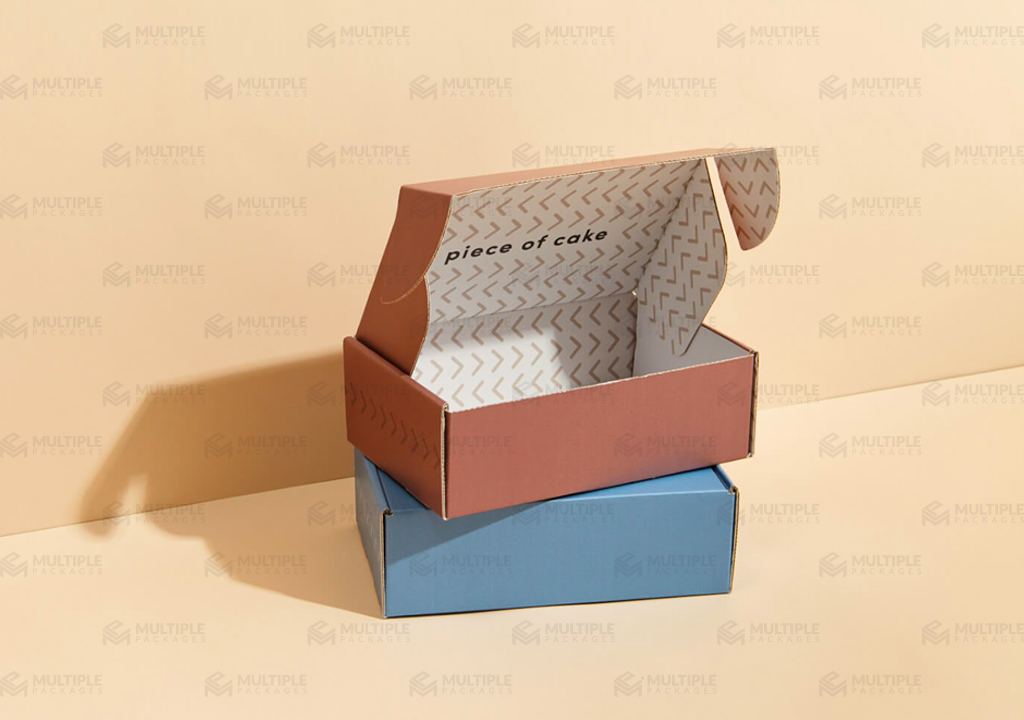Printing custom mailer boxes is fundamentally the process of applying colored ink. Ink transfer may include printing plates (flexo, litho-lam) or direct application using an inkjet depending on the technique being employed (digital).
Which print manufacturing technique you use when it comes to packaging depends on a number of variables. The kind of artwork you want to create and the way the colors are constructed into your file will both be important factors.
How color is created in your artwork file and the custom mailer box print manufacturing technique both affect how many print plates are required to transfer your image to your box, label, or shop display.
A pretty easy effect to accomplish is to apply your logo in black or as a 2-color print to the outside of the shipment box. However, this is a much trickier image to print if your packaging needs full-color imagery.
You should utilize the spot color model or CMYK custom mailer boxes depending on your design needs and the production process.
What Is CMYK Printing?
Cyan (C), Magenta (M), Yellow (Y), and Black are the four different pigmented inks used in the CMYK color model (K). Only a small portion of the Pantone color collection cannot be reproduced using CMYK; there are an infinite number of possible color combinations.
Pros
- The text printing on custom mailer boxes is inexpensive.
- Standardization instruction manuals are not necessary.
- Everybody can easily access it.
Cons
- Lack of worldwide color uniformity.
- Poor color fidelity for custom mailer boxes.
- Only simulates 55% of the common PMS print colors.
Digital CMYK Printing
CMYK inks are applied by inkjet directly to the material in the form of individual, tiny color dots.
These dots merge together from a distance to give the impression of being one continuous hue. If your package includes full-color artwork or photos, digital print is the best option because packaging designers can render almost any color using CMYK.
Compared to analog printing on custom mailer boxes, brands can purchase lower quantities and reorder more frequently because digital printing does not require print plates.
Additionally, brands are able to switch up their packaging design whenever they like without having to buy new print plates.
Digital printing has numerous advantages over analog printing in terms of sustainability. Since several common prepress techniques are no longer required, the environmental impact is greatly minimized.
Obsolescence is avoided, resulting in a reduction in outdated packaging and waste, thanks to the capacity to print on demand in precise order quantities.
Printing in Several Colors
CMYK is the best option if your packages call for creating a realistic image or design that requires multiple colors. Even if there is a risk for color variance, you can ask your vendor to run press checks to make sure the colors are the same.
Low Pitch
If you only require a small number of custom mailer boxes, PMS won’t be economical. Separate print plates are needed for each color, which adds to the overall cost. Therefore, to keep your costs as low as possible when you need low-volume prints, choose CMYK.
Internal Printing
PMS can be expensive for you if you are doing your own package printing. You need to buy specialized equipment, unique print plates for each design and color, and PMS instruction manuals. CMYK is the best option to avoid all that and save money.
Is CMYK Really the Better Option for Custom Mailer Boxes?
The amazing thing about CMYK is that it can render almost any color. You can only use the number of colors your printing press can print when using Pantone colors.
The print quality might not be as good due to the CMYK printing method of “dots,” though. More importantly, CMYK cannot ensure exact color accuracy. Whereas the Pantone system’s definition and history dictate that you should match relatively near.
Having said that, it’s not really up to you to decide between CMYK and Pantone.
How are you printing? is the main query.
Your products (custom mailer boxes, notecards, etc.) will probably use CMYK colors if they are printed using a digital print technique.
Software translates a picture from a screen to the printer in a digital printing process, which then prints the image on a substrate (using the CMYK process approach).
Pantone or CMYK colors can be used flexographically or offset when printing your goods.
By using the flexographic or offset printing method, a printing plate customized to your artwork is created. Your printing surface receives an ink “stamp” after the ink is applied to the printing plate.
Final Word
By default, Multiple Packages do not ensure that CMYK and PMS colors will match. Color matching can be time-consuming due to the nature of digital printing and variations between manufacturing runs of the board on which packaging is printed.
Contact our Multiple Packages experts for advice on artwork setup. Get a quote that includes the right kinds of proofing if your order requires PMS color-matching. Get custom retail boxes from the Multiple Packages now.
 +1(332)-233-6292
+1(332)-233-6292

